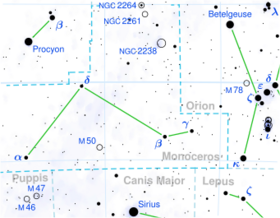Astronomy:Epsilon Monocerotis
From HandWiki
Short description: Binary star system in the constellation Monoceros
| Observation data {{#ifeq:J2000|J2000.0 (ICRS)|Epoch J2000.0 Equinox J2000.0 (ICRS)| Epoch J2000 [[Astronomy:Equinox (celestial coordinates)|Equinox J2000}} | |
|---|---|
| Constellation | Monoceros |
| ε Mon A | |
| Right ascension | 06h 23m 46.08471s[1] |
| Declination | 4° 35′ 34.3153″[1] |
| Apparent magnitude (V) | 4.39[2] |
| ε Mon B | |
| Right ascension | 06h 23m 46.48292s[1] |
| Declination | 4° 35′ 45.2307″[1] |
| Apparent magnitude (V) | 6.72[2] |
| Characteristics | |
| ε Mon A | |
| Spectral type | class = A5 IV[3] |
| U−B color index | +0.14[4] |
| B−V color index | +0.20[4] |
| ε Mon B | |
| Spectral type | F5 V[3] |
| U−B color index | −0.05[5] |
| B−V color index | +0.45[5] |
| Astrometry | |
| ε Mon A | |
| Radial velocity (Rv) | +13.10[6] km/s |
| Proper motion (μ) | RA: −22.06[1] mas/yr Dec.: +10.91[1] mas/yr |
| Parallax (π) | 26.67 ± 0.90[1] mas |
| Distance | 122 ± 4 ly (37 ± 1 pc) |
| Absolute magnitude (MV) | 1.52[2] |
| ε Mon B | |
| Radial velocity (Rv) | +12.40[6] km/s |
| Proper motion (μ) | RA: −21.86[1] mas/yr Dec.: +11.35[1] mas/yr |
| Parallax (π) | 26.95 ± 0.99[1] mas |
| Distance | 121 ± 4 ly (37 ± 1 pc) |
| Absolute magnitude (MV) | +3.88[2] |
| Details | |
| ε Mon A | |
| Mass | 2.04[7] M☉ |
| Radius | 2.5[8] R☉ |
| Luminosity | 25[7] L☉ |
| Surface gravity (log g) | 3.95[9] cgs |
| Temperature | 7,923[9] K |
| Metallicity [Fe/H] | −0.11[10] dex |
| Rotational velocity (v sin i) | 149[7] km/s |
| ε Mon B | |
| Mass | 1.16[8] M☉ |
| Radius | 1.1[8] R☉ |
| Luminosity | 2.39[2] L☉ |
| Surface gravity (log g) | 3.95[9] cgs |
| Temperature | 7,923[9] K |
| Rotational velocity (v sin i) | 25[3] km/s |
| Other designations | |
| ε Mon A: {{{names1}}} | |
| ε Mon B: {{{names2}}} | |
| Database references | |
| SIMBAD | data |
| SIMBAD | data |
ε Monocerotis, Latinised as Epsilon Monocerotis, is the Bayer designation of a binary star system in the equatorial constellation Monoceros. Its location is a guide for sky navigation toward the Rosette Nebula.[11]
The white-hued primary component has a stellar classification of A5 IV,[3] suggesting it is an aging subgiant star. Its apparent magnitude is 4.39[2] and it is approximately 122 light years away based on parallax.[1] It is reportedly a spectroscopic binary with a period around 331 days.[12]
The B component, at a separation of around 12.3",[12] is a yellow-white hued F-type main-sequence star of class F5 V[3] and an apparent magnitude of 6.72.[2]
References
- ↑ Jump up to: 1.00 1.01 1.02 1.03 1.04 1.05 1.06 1.07 1.08 1.09 1.10 Van Leeuwen, F. (2007). "Validation of the new Hipparcos reduction". Astronomy and Astrophysics 474 (2): 653–664. doi:10.1051/0004-6361:20078357. Bibcode: 2007A&A...474..653V. Vizier catalog entry A Vizier catalog entry B
- ↑ Jump up to: 2.0 2.1 2.2 2.3 2.4 2.5 2.6 Anderson, E.; Francis, Ch. (2012). "XHIP: An extended hipparcos compilation". Astronomy Letters 38 (5): 331. doi:10.1134/S1063773712050015. Bibcode: 2012AstL...38..331A. Vizier catalog entry A Vizier catalog entry B
- ↑ Jump up to: 3.0 3.1 3.2 3.3 3.4 Hoffleit, D.; Warren, W. H. (1995). "VizieR Online Data Catalog: Bright Star Catalogue, 5th Revised Ed. (Hoffleit+, 1991)". VizieR On-line Data Catalog: V/50. Originally Published in: 1964BS....C......0H 5050. Bibcode: 1995yCat.5050....0H.
- ↑ Jump up to: 4.0 4.1 Mallama, A. (2014). "Sloan Magnitudes for the Brightest Stars". The Journal of the American Association of Variable Star Observers 42 (2): 443. Bibcode: 2014JAVSO..42..443M.Vizier catalog entry
- ↑ Jump up to: 5.0 5.1 Mermilliod, J. C. (2006). "VizieR Online Data Catalog: Homogeneous Means in the UBV System (Mermilliod 1991)". VizieR On-line Data Catalog: II/168. Originally Published in: Institut d'Astronomie 2168. Bibcode: 2006yCat.2168....0M.Vizier catalog entry
- ↑ Jump up to: 6.0 6.1 Gontcharov, G. A. (2006). "Pulkovo Compilation of Radial Velocities for 35 495 Hipparcos stars in a common system". Astronomy Letters 32 (11): 759–771. doi:10.1134/S1063773706110065. Bibcode: 2006AstL...32..759G.
- ↑ Jump up to: 7.0 7.1 7.2 Zorec, J.; Royer, F. (2012). "Rotational velocities of A-type stars". Astronomy & Astrophysics 537: A120. doi:10.1051/0004-6361/201117691. Bibcode: 2012A&A...537A.120Z. Vizier catalog entry
- ↑ Jump up to: 8.0 8.1 8.2 Allende Prieto, C.; Lambert, D. L. (1999). "Fundamental parameters of nearby stars from the comparison with evolutionary calculations: Masses, radii and effective temperatures". Astronomy and Astrophysics 352: 555–562. Bibcode: 1999A&A...352..555A.
- ↑ Jump up to: 9.0 9.1 9.2 9.3 David, Trevor J.; Hillenbrand, Lynne A. (2015). "The Ages of Early-Type Stars: Strömgren Photometric Methods Calibrated, Validated, Tested, and Applied to Hosts and Prospective Hosts of Directly Imaged Exoplanets". The Astrophysical Journal 804 (2): 146. doi:10.1088/0004-637X/804/2/146. Bibcode: 2015ApJ...804..146D.
- ↑ Wu, Yue; Singh, H. P.; Prugniel, P.; Gupta, R.; Koleva, M. (2010). "Coudé-feed stellar spectral library – atmospheric parameters". Astronomy & Astrophysics 525: A71. doi:10.1051/0004-6361/201015014. Bibcode: 2011A&A...525A..71W.
- ↑ Kaler, James. "EPS MON (Epsilon Monocerotis)". STARS. University of Illinois. http://stars.astro.illinois.edu/sow/epsmon.html. Retrieved 2017-12-23.
- ↑ Jump up to: 12.0 12.1 Mason, Brian D.; Wycoff, Gary L.; Hartkopf, William I.; Douglass, Geoffrey G.; Worley, Charles E. (2001). "The 2001 US Naval Observatory Double Star CD-ROM. I. The Washington Double Star Catalog". The Astronomical Journal 122 (6): 3466. doi:10.1086/323920. Bibcode: 2001AJ....122.3466M. Vizier catalog entry
 |


